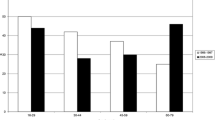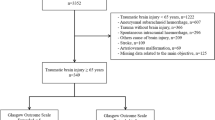Abstract
Goal
To describe the outcome of patients with severe traumatic brain injury (TBI) 3, 6 and 12 months after trauma.
Methods
Between January 2001 and December 2005, 13 European centres enrolled 1,172 patients with severe TBI defined as Glasgow Coma Scale (GCS) score < 9. Demographic data, trauma severity, results of computed tomography (CT) scans, data on status, treatment and outcome were recorded. The five-level Glasgow Outcome Scale (GOS) score was used to classify patients as having a “favourable” (GOS scores 5 and 4) or an “unfavourable outcome” (GOS scores 3, 2 and 1).
Results and conclusions
Of the 1,172 patients, 37% died in the intensive care unit (ICU) and 8.5% died after ICU discharge. At 12 months after trauma, almost half of the outcomes (46.6%) were classified as “favourable” (33% “good recovery”, 13.6% “moderate disability”) and 7.9% were classified as “unfavourable” (6.1% “severe disability”, 1.8% “vegetative status”). As in previous studies, long-term outcomes were influenced by age, severity of trauma, first GCS score, pupillary status and CT findings (e.g. subdural haematoma and closed basal cistern on the first CT scan). Patients with “good recovery” had a high likelihood to remain in that category (91%). Patients with “moderate disability” had a 50% chance to improve to “good recovery”. Patients with “severe disability” had a 40% chance to improve and had a 4% chance of death. Patients with “vegetative status” were more likely to die (42%) than to improve (31%). Changes were more likely to occur during the first than during the second half-year after trauma.
Similar content being viewed by others
References
Hyder AA, Wunderlich CA, Puvanachandra P, Gururaj G, Kobusingye OC. The impact of traumatic brain injuries: a global perspective. NeuroRehabilitation. 2007;22:341–53.
Tagliaferri F, Compagnone C, Korsic M, Servadei F, Kraus J. A systematic review of brain injury epidemiology in Europe. Acta Neurochir (Wien). 2006;148:255–68.
Mauritz W, Wilbacher I, Majdan M, Leitgeb J, Janciak I, Brazinova A, Rusnak M. Epidemiology, treatment and outcome of patients after severe traumatic brain injury in European regions with different economic status. Eur J Public Health. 2008;18:575–80.
Rusnak M, Janciak I, Majdan M, Wilbacher I, Mauritz W. Severe traumatic brain injury in Austria I: introduction to the study. Wien Klin Wochenschr. 2007;119:23–8.
Mauritz W, Rusnak M, Janciak I. Implementing scientific evidence-based guidelines: case study of severe traumatic brain injuries. Clin Res Regul Affairs. 2003;20:81–7.
Choi SC, Barnes TY, Bullock R, Germanson TA, Marmarou A, Young HF. Temporal profile of outcomes in severe head injury. J Neurosurg. 1994;81:169–73.
King JT Jr, Carlier PM, Marion DW. Early Glasgow Outcome Scale scores predict long-term functional outcome in patients with severe traumatic brain injury. J Neurotrauma. 2005;22:947–54.
Marshall LF, Becker DP, Bowers SA, Cayard C, Eisenberg H, Gross CR, Grossman RG, Jane JA, Kunitz SC, Rimel R, Tabaddor K, Warren J. The National Traumatic Coma Data Bank. Part 1: design, purpose, goals, and results. J Neurosurg. 1983;59:276–84.
Bullock R, Chesnut RM, Clifton G, Ghajar J, Marion DW, Narayan RK, Newell DW, Pitts LH, Rosner MJ, Wilberger JW. Guidelines for the management of severe head injury. Brain Trauma Foundation. Eur J Emerg Med. 1996;3:109–27.
Boyd CR, Tolson MA, Copes WS. Evaluating trauma care: the TRISS method. Trauma Score and the Injury Severity Score. J Trauma. 1987;27:370–8.
Firsching R, Woischneck D. Present status of neurosurgical trauma in Germany. World J Surg. 2001;25:1221–3.
Masson F, Thicoipe M, Mokni T, Aye P, Erny P, Dabadie P; Aquaitaine Group for Severe Brain Injury Study. Epidemiology of traumatic comas: a prospective population-based study. Brain Inj. 2003;17:279–93.
Marshall LF, Maas AI, Marshall SB, Bricolo A, Fearnside M, Iannotti F, Klauber MR, Lagarrigue J, Lobato R, Persson L, Pickard JD, Piek J, Servadei F, Wellis GN, Morris GF, Means ED, Musch B. A multicenter trial on the efficacy of using tirilazad mesylate in cases of head injury. J Neurosurg. 1998;89:519–25.
Maas AI, Murray G, Henney H 3rd, Kassem N, Legrand V, Mangelus M, Muizelaar JP, Stocchetti N, Knoller N; Pharmos TBI investigators. Efficacy and safety of dexanabinol in severe traumatic brain injury: results of a phase III randomised, placebo-controlled, clinical trial. Lancet Neurol. 2006;5:38–45.
Lu J, Marmarou A, Choi S, Maas A, Murray G, Steyerberg EW; Impact and Abic Study Group. Mortality from traumatic brain injury. Acta Neurochir Suppl. 2005;95:281–5.
Kraus JF, Peek-Asa C, McArthur D. The independent effect of gender on outcomes following traumatic brain injury: a preliminary investigation. Neurosurg Focus. 2000;8:e5.
Davis DP, Douglas DJ, Smith W, Sise MJ, Vilke GM, Holbrook TL, Kennedy F, Eastman AB, Velky T, Hoyt DB. Traumatic brain injury outcomes in pre- and post-menopausal females versus age-matched males. J Neurotrauma. 2006;23:140–8.
Hukkelhoven CW, Steyerberg EW, Habbema JD, Farace E, Marmarou A, Murray GD, Marshall LF, Maas AI. Predicting outcome after traumatic brain injury: development and validation of a prognostic score based on admission characteristics. J Neurotrauma. 2005;22:1025–39.
Signorini DF, Andrews PJ, Jones PA, Wardlaw JM, Miller JD. Predicting survival using simple clinical variables: a case study in traumatic brain injury. J Neurol Neurosurg Psychiatry. 1999;66:20–5.
Stiver SI, Manley GT. Prehospital management of traumatic brain injury. Neurosurg Focus. 2008;25:E5.
Lippert-Grüner M, Lefering R, Svestkova O. Functional outcome at 1 vs. 2 years after severe traumatic brain injury. Brain Inj. 2007;21:1001–5.
Pagulayan KF, Temkin NR, Machamer J, Dikmen SS. A longitudinal study of health-related quality of life after traumatic brain injury. Arch Phys Med Rehabil. 2006;87:611–8.
Acknowledgments
We are very grateful to the collaborators from the participating centres: M. Bartosova MD (Michalovce, Slovakia), F. Botha MD (Linz, Austria), F. Chmeliczek MD (Salzburg, Austria), G. Clarici MD (Graz, Austria), J. de Riggo MD (St. Martin, Slovakia), K. Dizdarevic MD (Sarajevo, Bosnia-Herzegovina), D. Girotto MD (Rijeka, Croatia), H.-D. Gulle MD (Klagenfurt, Austria), M. Kaniansky MD (Banska Bystrica, Slovakia), W. Moser MD (Klagenfurt, Austria), Prof. M. Soljakova MD (Skopje, Former Yugoslav Republic of Macedonia), B. Splavski MD (Osijek, Croatia), Prof. Z. Todorova MD (Skopje, Former Yugoslav Republic of Macedonia), Ernst Trampitsch MD (Klagenfurt, Austria), Prof. M. Vukic MD (Zagreb, Croatia). The data used for this study were collected for a project funded by a European Union grant (Project “Research–Treat–TBI”; 6th Framework Program: INCO-DEV: International Cooperation with Developing Countries 1998–2002; contract number: ICA2-CT-2002-100) and for another project funded by the Austrian Worker’s Compensation Board (AUVA; contract number FK 33/2003) and by the “Jubiläumsfonds” of the Austrian National Bank (project number 8987). The International Neurotrauma Research Organization (INRO) was supported by an annual grant from Mrs. Ala Auersperg-Isham and Mr. Ralph Isham, and by donations from various sources.
Conflict of interest
None.
Author information
Authors and Affiliations
Corresponding author
Rights and permissions
About this article
Cite this article
Mauritz, W., Wilbacher, I., Leitgeb, J. et al. One-year outcome and course of recovery after severe traumatic brain injury. Eur J Trauma Emerg Surg 37, 387–395 (2011). https://doi.org/10.1007/s00068-010-0053-6
Received:
Accepted:
Published:
Issue Date:
DOI: https://doi.org/10.1007/s00068-010-0053-6




